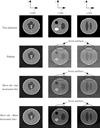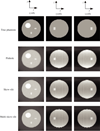An analytical algorithm for skew-slit collimator SPECT with uniform attenuation correction
- PMID: 17110780
- PMCID: PMC5314945
- DOI: 10.1088/0031-9155/51/23/018
An analytical algorithm for skew-slit collimator SPECT with uniform attenuation correction
Abstract
To replace the conventional pinhole (normal cone-beam) collimator, a novel skew-slit collimator was previously proposed and a Novikov-type algorithm developed to reconstruct images using the skew-slit geometry. The goal of this paper is to develop a reconstruction algorithm that has better noise control than the Novikov-type algorithm. The new algorithm is able to compensate for uniform attenuation, and computer simulation results show that reconstructed images are less noisy.
Figures










Similar articles
-
An analytical algorithm for skew-slit imaging geometry with nonuniform attenuation correction.Med Phys. 2006 Apr;33(4):997-1004. doi: 10.1118/1.2174719. Med Phys. 2006. PMID: 16696476
-
Correction of photon attenuation and collimator response for a body-contouring SPECT/CT imaging system.J Nucl Med. 2005 May;46(5):868-77. J Nucl Med. 2005. PMID: 15872362 Clinical Trial.
-
A skew-slit collimator for small-animal SPECT.J Nucl Med Technol. 2008 Dec;36(4):207-12. doi: 10.2967/jnmt.108.055582. Epub 2008 Nov 13. J Nucl Med Technol. 2008. PMID: 19008286 Free PMC article.
-
Exact fan-beam and 4pi-acquisition cone-beam SPECT algorithms with uniform attenuation correction.Med Phys. 2005 Nov;32(11):3440-7. doi: 10.1118/1.2068907. Med Phys. 2005. PMID: 16372416
-
[Analytical algorithms improving the reconstruction of SPECT image].Sheng Wu Yi Xue Gong Cheng Xue Za Zhi. 2005 Jun;22(3):641-4. Sheng Wu Yi Xue Gong Cheng Xue Za Zhi. 2005. PMID: 16013279 Review. Chinese.
Cited by
-
Adaptive SPECT imaging with crossed-slit apertures.Proc SPIE Int Soc Opt Eng. 2014 Aug 17;9214:92140E. doi: 10.1117/12.2066188. Proc SPIE Int Soc Opt Eng. 2014. PMID: 26190884 Free PMC article.
-
High-resolution, anamorphic, adaptive small-animal SPECT imaging with silicon double-sided strip detectors.Proc SPIE Int Soc Opt Eng. 2011 Aug 21;8143:81430G. doi: 10.1117/12.896729. Proc SPIE Int Soc Opt Eng. 2011. PMID: 26346619 Free PMC article.
-
High-Resolution Anamorphic SPECT Imaging.IEEE Trans Nucl Sci. 2014 Jun;61(3):1126-1135. doi: 10.1109/TNS.2014.2304853. IEEE Trans Nucl Sci. 2014. PMID: 26160983 Free PMC article.
-
Analytic Derivation and Monte Carlo Validation of a Sensitivity Formula for Slit-Slit Collimation With Penetration.IEEE Trans Nucl Sci. 2010 Feb 8;57(1):135-143. doi: 10.1109/TNS.2009.2030580. IEEE Trans Nucl Sci. 2010. PMID: 20352062 Free PMC article.
-
Noise-Weighted FBP Algorithm for Uniformly Attenuated SPECT Projections.IEEE Trans Nucl Sci. 2016 Jun;63(3):1435-1439. doi: 10.1109/TNS.2016.2564924. Epub 2016 Jun 23. IEEE Trans Nucl Sci. 2016. PMID: 27840452 Free PMC article.
References
-
- Beekman FJ, Vastenhouw B. Design and simulation of a high-resolution stationary SPECT system for small animals. Phys. Med. Biol. 2004;49:4579–4592. - PubMed
-
- Beekman FJ, van der Have F, Vastenhouw B, van der Linden AJA, van Rijk PP, Burbach JPH, Smidt MP. U-SPECT-I: a novel nystem for submillimeter-resolution tomography with radiolabeled molecules in mice. J. Nucl. Med. 2005;46:1194–1200. - PubMed
-
- Bellini S, Piacenti M, Caffario C, Rocca F. Compensation of tissue absorption in emission tomography. IEEE Trans. Acoust. Speech Signal Process. 1979;27:213–218.
-
- Cao Z, Bal G, Accorsi R, Acton PD. Optimal number of pinholes in multi-pinhole SPECT for mouse brain imaging—a simulation study. Phys. Med. Biol. 2005;50:4609–4624. - PubMed
-
- Clough AV, Barrett HH. Attenuated Radon and Abel transforms. J. Opt. Soc. Am. 1983;73:1590–1595.
Publication types
MeSH terms
Grants and funding
LinkOut - more resources
Full Text Sources
Other Literature Sources
